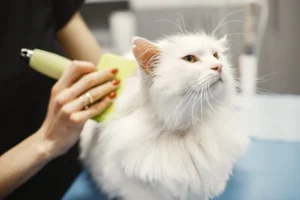Is your dog pulling out his hair? You’re not alone. Many pet owners experience this distressing behavior, and it can be puzzling to figure out why it’s happening.
There are a variety of reasons your pup might be tugging out his own fur, ranging from allergies to stress, or even medical issues that need attention. But hold on—there’s a lot more to unpack about your furry friend’s grooming habits below. You’ll find insights that could help unravel the mystery!

Common Causes of Hair Pulling
It’s concerning when you notice your dog pulling out his hair. Understanding the root cause is critical for addressing this behavior effectively. Here are a few common reasons behind this troubling habit:
Boredom: Dogs need mental and physical stimulation. Without it, they might resort to hair pulling as a way to entertain themselves. Incorporate more playtime or give them puzzle toys to keep their minds engaged.
Stress and Anxiety: Just like people, dogs can experience stress. Changes in their environment—new family members, moving homes, or loud noises—can trigger anxiety. Hair pulling can be a coping mechanism during these stressful times.
Skin Irritations: If there’s an underlying skin issue, such as infections or irritations, dogs may pull out hair to relieve the discomfort. Regular grooming and check-ups can help spot these problems early.
Parasites: Fleas, ticks, and mites can cause significant itching that leads to hair pulling. Regular flea and tick prevention is essential for maintaining your dog’s skin health.
Compulsive Behavior: Some dogs develop obsessive habits, including hair pulling, especially if it’s become a learned behavior over time. This might require behavioral training or consultation with a veterinarian.
Identifying the reason your dog is pulling out his hair is the first step toward helping him. Consider keeping a diary of his behavior to spot patterns and triggers, and don’t hesitate to reach out to your veterinarian for advice tailored to your dog’s specific situation.
Are Allergies to Blame?
Allergies are a common culprit behind hair pulling, and they can be tricky to diagnose. Both environmental and food allergies can lead to serious discomfort, including itchiness and hair loss.
Environmental Allergies
Dogs can be sensitive to various environmental factors, such as pollen, dust mites, and mold. When exposed, they often show signs like excessive licking, scratching, and hair pulling. Seasonal changes can exacerbate these allergies, particularly during spring and fall when pollen counts rise.
Food Allergies
Food allergies can make your dog itchy and uncomfortable too. Ingredients like wheat, corn, or certain proteins often trigger reactions. If you suspect a food allergy, an elimination diet under your vet’s guidance can help pinpoint the culprit.
Unique Insight
It’s worth noting that dogs with compromised immune systems, such as those with underlying health conditions or chronic skin infections, may be more prone to allergies and subsequent hair pulling. Regular veterinary check-ups can help manage their overall well-being, ensuring issues are caught early.
If you think allergies are to blame for your dog’s hair pulling, consult your vet for testing and tailored treatment plans. A comprehensive plan can make a world of difference in alleviating your dog’s discomfort and improving his quality of life.
Is Stress or Anxiety a Factor?
Dogs are sensitive creatures, and their emotional state can directly affect their behavior. If your dog is pulling out his hair, stress or anxiety could be major players. Stressors in the environment—like loud noises, changes in routine, or even the presence of other pets—can trigger compulsive grooming behaviors. You might notice your pup licking or chewing at his fur much more when he’s feeling anxious or uncomfortable.
Environmental factors aren’t always easy to spot. Keep an eye out for patterns: Does the hair-pulling happen after a visit to the vet or during thunderstorms? Creating a calm space for your dog with cozy beds or soft music can help minimize stress. Regular exercise and playtime also play crucial roles in reducing anxiety levels. If you suspect stress is causing this behavior, don’t hesitate to consult your vet or a dog behavior specialist for tailored strategies.
Could It Be a Medical Condition?
While stress can lead to hair loss, medical issues shouldn’t be overlooked. There are various conditions that might cause your dog to pull out his hair or lose it altogether. Here are some potential culprits:
- Skin Infections: Bacterial or fungal infections can cause itching and discomfort, prompting your dog to pull out his fur desperately.
- Hormonal Imbalances: Conditions like hypothyroidism or Cushing’s disease can lead to hair loss. These hormonal changes can wreak havoc on your dog’s health.
- Allergies: Food allergies or environmental allergens (like pollen) can cause itchy skin, leading to excessive grooming.
- Parasites: Fleas, mites, and ticks can irritate the skin and cause hair loss when dogs scratch or bite at the affected areas.
If you notice patches of hair loss, redness, or irritation, it’s important to get your pup checked out by a veterinarian. A thorough examination can help pinpoint any underlying medical issues, leading to the right treatment plan. Regular vet visits can also catch potential problems before they escalate, keeping your furry friend happy and healthy.
Importance of Behavioral Issues
Hair pulling in dogs often stems from behavioral issues, and understanding this can shed light on what’s happening. Boredom is a common culprit; when dogs don’t have enough stimulation—be it physical exercise or mental engagement—they might resort to hair pulling as a way to cope with their frustration or anxiety. It’s also noteworthy that some dogs develop learned behaviors; they may start pulling their hair as a response to stress or even as part of a pattern that develops due to a lack of boundaries. Addressing these behavioral aspects is crucial—altering their environment, providing more interactive toys, or engaging in regular play can often make a significant difference.
What Do You Need to Look For?
It’s essential to keep an eye on specific signs that can indicate whether your dog’s hair pulling is a serious concern. Some key symptoms to watch for include:
- Excessive pulling: If your dog is pulling out clumps of hair rather than just nibbling at it.
- Red or inflamed skin: This could indicate infection or skin irritation.
- Change in behavior: If your usually playful pup seems withdrawn or anxious.
- Licking or chewed spots: Areas where the hair is missing and skin is exposed might signal deeper issues.
- Frequent scratching: This could suggest allergies or dermatological problems.
If you notice a combination of these signs, it’s wise to consult with a veterinarian or a behaviorist. Early intervention can prevent further complications and help your furry friend lead a healthier, happier life. Pay attention—the more you know, the better you can advocate for your dog’s well-being.
When to See a Vet
It’s not uncommon for dog owners to notice their furry friends pulling out their hair, but pinpointing the right time to seek professional help is crucial. If you see red, inflamed skin or bald patches, it’s a clear signal that something isn’t right. Frequent scratching, biting the skin, or excessive licking could indicate a skin infection or allergies. Additionally, if your dog seems unusually itchy, lethargic, or is showing signs of distress, don’t hesitate to reach out to your vet. If the hair pulling has lasted for more than a few days or if you notice changes in behavior, it’s essential to have a professional evaluation. Early intervention can make a world of difference in preventing more severe issues down the line.
Can Diet Play a Role?
Your dog’s diet can significantly influence their skin health and coat quality. Poor nutrition can lead to deficiencies, showing up in the coat as dryness, flakiness, or even increased shedding. Key ingredients to look for include Omega-3 and Omega-6 fatty acids, which help support skin integrity and moisture. Foods rich in antioxidants, like fruits and veggies, can promote healing and combat inflammation.
Consider how certain ingredients could spark allergies, contributing to hair pulling. Common culprits include chicken, beef, dairy, and grains. If you suspect your pup’s diet is to blame, consult with your vet about food trials or hypoallergenic diets. This kind of targeted approach not only helps with hair pull issues but can enhance your dog’s overall well-being.
To sum it up, pay attention to what you’re feeding your furry friend—it can be a game-changer in addressing their grooming problems.
Trivia and Interesting Facts
Did you know that approximately 60% of dogs experience some form of stress-related behavior during their lives? A common manifestation of this is excessive grooming or pulling out hair. Research indicates that behaviors like human stress can impact our pets too; dogs often mirror their owner’s anxiety levels. In fact, studies have shown that breeds with separation anxiety, such as Labrador Retrievers and Jack Russell Terriers, are particularly prone to these behaviors. Furthermore, dermatological conditions can lead to increased grooming, with around 30% of vet visits focusing on skin-related issues. These insights highlight the importance of monitoring not just our pets’ physical health but their emotional well-being as well.
Finding Solutions for Your Dog
Understanding why your dog is pulling out his hair is just the first step. To effectively address this behavior, you can try a range of practical solutions.
1. Identify Triggers: Look for patterns in your dog’s behavior to determine what makes him anxious—be it loud noises, separation, or changes in routine.
2. Regular Exercise: A tired dog is often a happy dog. Incorporating daily walks and playtime can help alleviate boredom and anxiety.
3. Create a Calm Environment: Consider using calming diffusers or sound machines to create a peaceful space for your dog, especially during stressful times.
4. Groom Regularly: Engaging in regular grooming can help reduce the urge to self-groom excessively. It’s also a great opportunity for bonding.
5. Check for Skin Issues: Schedule a vet visit to rule out any medical concerns like allergies or infections that could be causing discomfort.
6. Behavioral Training: Working with a professional trainer or canine behaviorist can provide tailored strategies to manage anxiety and compulsive behaviors.
If your dog’s issue persists, seeking a veterinarian’s advice is crucial, as they might recommend medication or specific therapies.
Alex, a passionate animal lover, has experience in training and understanding animal behavior. As a proud pet parent to two dogs and three cats, he founded AnimalReport.net to share insights from animal experts and expand his knowledge of the animal kingdom.




